
Tourists can explore the most beautiful historical sites in Bangladesh, where centuries-old architecture, rich cultural heritage, and stunning landmarks offer a captivating glimpse into the nation’s vibrant past. Ideal for tourists seeking to delve into history and beauty.
Historical sites for tourists in Bangladesh:
1. Lalbagh Fort
2. Somapura Mahavihara
3. Ahsan Manzil
4. Sixty Dome Mosque (Shat Gombuj Masjid)
5. Mahasthangarh
6. Panam City
7. Mainamati
8. Kantaji Temple (Kantajew Temple)
9. Star Mosque (Tara Masjid)
10. Liberation War Museum
1. Lalbagh Fort Bangladesh
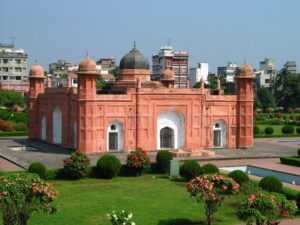
Tourists can visit Lalbagh Fort, one of the historical sites, located in the heart of old Dhaka, Bangladesh, and is a historical treasure that reflects the architectural grandeur and cultural richness of the Mughal era.
Commissioned in 1678 by Prince Muhammad Azam, son of Emperor Aurangzeb, the fort remains an unfinished yet compelling example of Mughal architecture in the Indian subcontinent.
Approaching Lalbagh Fort, visitors are greeted by its impressive gateway, known as the “Elephant Road,” which leads into a sprawling complex encompassing mosques, audience halls, and residential areas.
The fort’s main structure, the imposing Lalbagh Fortification, stands unfinished but offers a glimpse into its original design and intended grandeur.
The fort’s centerpiece is the mausoleum of Pari Bibi, built within a multi-domed structure adorned with intricate marble carvings and surrounded by lush gardens and water features.
The Lalbagh Fort also houses the Diwan-i-Aam (Hall of Audience), where the Mughal governor would meet with his subjects, and the Hammam Khana (Bath House), showcasing the architectural and engineering prowess of the Mughals.
Exploring Lalbagh Fort allows tourists to delve into Bangladesh’s rich history and cultural heritage, with exhibits displaying artifacts, manuscripts, and weaponry from the Mughal period.
The fort’s strategic location near the Buriganga River provides picturesque views and an insight into its military significance during the colonial era.
Today, Lalbagh Fort serves as a popular cultural attraction and a serene oasis amidst the bustling streets of Old Dhaka, inviting visitors to wander through its historic corridors, admire its architectural splendor, and uncover the stories of its royal patrons and builders.
2. Somapura Mahavihara Bangladesh
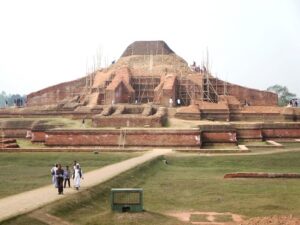
Somapura Mahavihara, located near the town of Paharpur in Bangladesh, is an ancient Buddhist monastery complex and UNESCO World Heritage site that is a testament to the region’s rich cultural and religious heritage.
Tourists can explore the Somapura Mahavihara, located near the town of Paharpur in Bangladesh, which is one of the historical sites, an ancient Buddhist monastery complex, and a UNESCO World Heritage Site that is part of the region’s rich heritage. Evidence of cultural and religious heritage.
Built during the Pala Empire in the 8th century CE, Somapura Mahavihara served as a center of learning and pilgrimage for Buddhist monks and scholars across South Asia.
As visitors approach Somapura Mahavihara, the vastness and architectural splendor of the complex, which covers an area of approximately 11 hectares, strikes them.
The site’s centerpiece is the imposing central stupa, surrounded by a square courtyard with 177 monastic cells arranged in rows, demonstrating the structured layout typical of ancient Buddhist monastic architecture.
The main temple structure, known as the Mandapa, features intricately carved terracotta plaques depicting scenes from the life of the Buddha, Jataka tales, and mythical creatures, offering insights into the artistic and religious practices of the Pala period.
Exploring Somapura Mahavihara allows tourists to wander through its well-preserved ruins, including the remains of meditation cells, stupas, shrines, and a central courtyard that once bustled with activity.
The site’s museum houses a collection of artifacts excavated from the area, including statues, pottery, and inscriptions, providing further context to the site’s historical significance.
Somapura Mahavihara continues to be a place of pilgrimage for Buddhists and a destination for tourists seeking to immerse themselves in Bangladesh’s ancient past and architectural marvels.
3. Ahsan Manzil Bangladesh
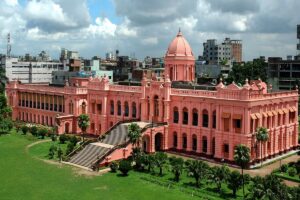
Ahsan Manzil, also known as the Pink Palace, is a historic architectural gem located on the banks of the Buriganga River in Dhaka, Bangladesh.
Built during the late 19th century, this magnificent structure served as the official residence and seat of the Nawabs of Dhaka, and later became the residence of the British colonial administrators.
As tourists approach Ahsan Manzil, its distinctive pink facade, standing out against the bustling streets of Old Dhaka, greets them.
The palace’s architectural style blends Indo-Saracenic and European influences, featuring ornate domes, verandas, and balconies adorned with intricate motifs and carvings.
The interior of Ahsan Manzil is equally impressive, with spacious halls, marble staircases, and an opulent Durbar Hall where formal receptions and ceremonies were held. The palace’s rooms are furnished with period furniture, chandeliers, and artifacts that reflect the luxurious lifestyle of its former residents.
Ahsan Manzil also houses a museum that showcases a collection of photographs, paintings, and artifacts from the Nawabi era, offering insights into the cultural and social life of Dhaka during the colonial period.
A visit to Ahsan Manzil provides tourists with a captivating journey through Bangladesh’s royal heritage and architectural legacy, highlighting its significance as a symbol of Dhaka’s historical and cultural identity.
4. Sixty Dome Mosque (Shat Gombuj Masjid) Bangladesh
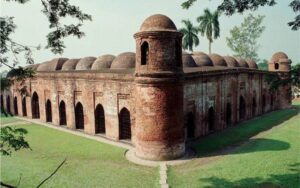
The Sixty Dome Mosque, also known as Shat Gombuj Masjid, is a remarkable architectural marvel located in Bagerhat, Bangladesh, and stands as a testament to the region’s rich history and cultural heritage.
This mosque is one of the historical sites in Bangladesh, built in the 15th century during the Bengal Sultanate by Khan Jahan Ali, a respected Muslim saint and ruler, this mosque is famous for its unique Tughlaq style architecture. which attracts tourists.
<div class=”min-h-[20px] text-message flex flex-col items-start whitespace-pre-wrap break-words [.text-message+&]:mt-5 juice:w-full juice:items-end overflow-x-auto gap-2″ dir=”auto” data-message-author-role=”assistant” data-message-id=”f6976d50-c788-4b95-a945-0334ee4d42af”>
As visitors approach the Sixty Dome Mosque, its imposing structure, characterized by sixty massive domes that give the mosque its name, strikes them.
Inside, the mosque’s prayer hall is vast and airy, supported by numerous pillars that create a forest-like appearance when viewed from within.
Delicate terracotta decorations adorn the pillars and walls, depicting floral motifs, geometric patterns, and scenes from daily life and religious stories, providing a visual feast for visitors.
A tranquil courtyard and gardens surround the Sixty Dome Mosque; thus, it offers a peaceful setting for reflection and contemplation.
Adjacent to the mosque is the tomb of Khan Jahan Ali, which attracts pilgrims and visitors alike seeking blessings and spiritual solace.
A visit to the Sixty Dome Mosque provides tourists with an opportunity to marvel at Bangladesh’s architectural heritage and religious significance.
Its grandeur, historical importance, and artistic beauty make it a must-see destination for those interested in exploring the cultural richness of South Asia and the Bengal Sultanate period.
5. Mahasthangarh Bangladesh
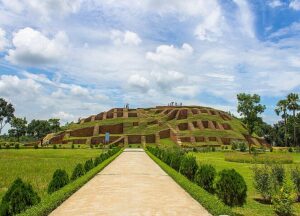
Mahasthangarh, located near Bogra in Bangladesh, is an ancient archaeological site that holds significant historical and cultural importance as one of the oldest urban centers in the Indian subcontinent.
Believed to have been the capital of the ancient kingdom of Pundranagara and later a prominent city during the Maurya and Gupta empires, Mahasthangarh dates back over 2,500 years.
Approaching Mahasthangarh, tourists are greeted by the remnants of a fortified citadel surrounded by impressive ramparts and moats, reflecting its strategic importance in ancient times.
The site covers a vast area, with excavated ruins revealing the layout of streets, residential quarters, temples, and public buildings that once thrived within its walls.
The centerpiece of Mahasthangarh is the 3rd-century BCE citadel, where visitors can explore ancient structures such as the Govinda Bhita Temple, dedicated to Lord Vishnu, and the fortified area known as the Gokul Medh, which served as a palace or administrative center.
The archaeological site also includes the Mahasthangarh Museum, which houses a rich collection of artifacts unearthed from the area, including sculptures, pottery, coins, and inscriptions that provide insights into the daily life, culture, and religious practices of ancient Bangladesh.
Surrounded by lush greenery and offering panoramic views of the surrounding countryside, Mahasthangarh is not only a historical treasure but also a serene and picturesque destination.
Guided tours and informative signage at the site help tourists to appreciate the significance of Mahasthangarh in the context of South Asia’s ancient civilizations and its enduring legacy in Bangladesh’s cultural heritage.
6. Panam City Bangladesh
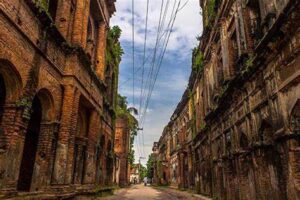
Panam City, located in Sonargaon near Dhaka, Bangladesh, is one of the historical sites that offers tourists a glimpse into the region’s rich heritage and architectural splendor from the Mughal and colonial periods.
Once a thriving trading center along the riverbanks of the Brahmaputra, Panam City flourished as a hub for cotton textiles and muslin during the 19th century.
Approaching Panam City, visitors are transported back in time as they explore its well-preserved colonial-era buildings and Mughal-style architecture.
The cityscape features grand mansions, imposing gateways, and intricately carved facades adorned with terracotta motifs and ornamental designs, reflecting the cultural fusion of Bengali, Mughal, and European influences.
The centerpiece of Panam City is the Panam Nagar, a row of meticulously restored 19th-century mansions that once belonged to wealthy Hindu merchants and landowners.
These mansions, characterized by their spacious courtyards, verandas, and towering columns, provide insights into the opulent lifestyle and architectural grandeur of the era.
Visitors to Panam City can stroll through its narrow lanes; furthermore, they can visit the Panam Nagar Museum housed in one of the historic buildings and admire the craftsmanship of the terracotta decorations that adorn many facades.
The area’s serene ambiance and lush surroundings, including nearby gardens and ponds, offer a tranquil setting for leisurely exploration and photography.
Panam City also serves as a cultural hub, hosting festivals, art exhibitions, and cultural events that celebrate Bangladesh’s history and architectural heritage.
Guided tours and informative displays help tourists appreciate the significance of Panam City in preserving the country’s cultural legacy and historical identity.
7. Mainamati Bangladesh
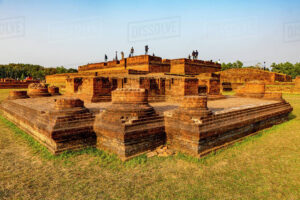
Mainamati, situated near Comilla in Bangladesh, is an ancient archaeological site renowned for its rich heritage of Buddhist monastic complexes, stupas, and relics dating back over a millennium.
Meenamati, located near Comilla in Bangladesh, is one of the ancient archaeological and historical sites known for its magnificent heritage of Buddhist monastic complexes, stupas, and relics dating back a thousand years that attract tourists.
Nestled amidst rolling hills and lush greenery, Mainamati offers tourists a serene and historically significant journey through Bangladesh’s cultural past; furthermore, it provides a unique glimpse into the region’s rich heritage.
Approaching Mainamati, visitors greet a landscape dotted with remnants of Buddhist civilization, including sprawling monastery complexes, ancient stupas, and intricately carved stone sculptures.
The site covers a wide area; moreover, excavated ruins reveal the layout of ancient settlements and the religious practices of the region.
The centerpiece of Mainamati is the Shalban Vihara, an extensive monastery complex dating back to the 7th century CE.
This archaeological gem features remains of monastic cells, prayer halls, and ornamental terracotta plaques depicting scenes from the life of the Buddha; furthermore, intricate floral motifs adorn the site.
Other notable sites in Mainamati include the Kutila Mura, a fortified monastery with a circular plan; additionally, the Ananda Vihara is known for its impressive monastic architecture and serene surroundings.
The Mainamati Museum, located nearby, houses a rich collection of artifacts excavated from the area, including ancient coins, pottery, sculptures, and inscriptions that provide insights into the daily life, trade, and religious beliefs of the region’s ancient inhabitants.
Surrounded by peaceful countryside and offering panoramic views of the hills and valleys, Mainamati is not only a historical treasure but also a tranquil retreat for visitors seeking to explore Bangladesh’s ancient Buddhist heritage and architectural marvels.
8. Kantaji Temple (Kantajew Temple) Bangladesh
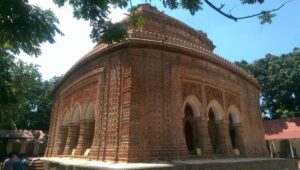
Tourists can explore Kantaji Temple, also known as Kantajiva Temple, is a magnificent Hindu temple located in Kantanagar, Dinajpur, Bangladesh, and is one of the historical sites that dates back to the late medieval period. Terracotta is a masterpiece of architecture.
Built in the 18th century by Maharaja Pran Nath of Dinajpur, this temple is dedicated to Lord Krishna and is renowned for its ornate terracotta carvings and architectural grandeur.
Tourists approaching Kantaji Temple immediately notice its towering structure and intricately embellished facade.
The temple’s terracotta panels depict a rich tapestry of mythological scenes, religious motifs, floral patterns, and intricate geometric designs, showcasing the artistic prowess and craftsmanship of Bengal’s artisans during that era.
The central structure of Kantaji Temple consists of a naat mandap (front porch), followed by a porch and three sanctuaries (garbhagrihas) where the deities were once worshipped.
Multiple ornate shikharas (spires) adorned with kalasa finials crown the temple, adding to its architectural splendor.
Inside, visitors can explore the sanctuaries and admire the exquisite terracotta panels that adorn the walls and pillars.
These panels not only serve as decorative elements but also narrate stories from Hindu epics such as the Ramayana and Mahabharata, as well as scenes depicting daily life and social customs of the time.
Surrounding Kantaji Temple is a spacious courtyard and gardens, providing a serene setting for contemplation and photography.
The temple complex also includes smaller shrines dedicated to other deities, reflecting the religious and cultural diversity of the region.
A visit to Kantaji Temple offers tourists a unique opportunity to admire Bangladesh’s architectural heritage and artistic traditions, while also exploring the spiritual significance and historical legacy of Hindu temples in the region.
9. Star Mosque (Tara Masjid) Bangladesh
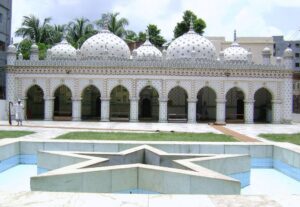
The Star Mosque, locally known as Tara Masjid, is a mesmerizing architectural gem located in Armanitola, Dhaka, Bangladesh.
Built in the early 19th century, this mosque is renowned for its stunning mosaic decorations and intricate designs adorn its facade; therefore, it is a must-visit destination for tourists interested in Islamic art and architecture.
Approaching the Star Mosque, visitors are immediately captivated by its facade, which is covered with hundreds of blue star-shaped tiles, earning it the name “Star Mosque.”
These tiles, imported from Japan and Belgium, form intricate floral and geometric patterns that shimmer in the sunlight; consequently, they create a mesmerizing visual spectacle.
The main prayer hall features ornate chandeliers, as well as marble flooring and wooden columns intricately carved with floral motifs.
One of the most distinctive features of the Star Mosque is its three onion-shaped domes adorned with Islamic motifs and topped with kalasa finials, adding to its architectural elegance and grandeur.
Surrounded by a serene courtyard and gardens, the Star Mosque offers a tranquil retreat; moreover, it stands amidst the bustling streets of Dhaka.
Visitors can explore the mosque’s prayer halls, take in the intricate details of its decorations, and learn about its historical and cultural significance through informative displays and guided tours.
A visit to the Star Mosque provides tourists with a unique opportunity to appreciate Bangladesh’s rich Islamic heritage and artistic traditions, while also experiencing the spiritual ambiance and architectural beauty of this historic site.
10. Liberation War Museum Bangladesh
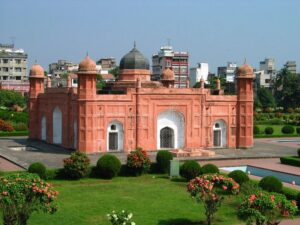
The Liberation War Museum in Dhaka, Bangladesh, stands as a poignant testament to the country’s struggle for independence and its journey towards freedom.
Established in 1996, the museum is dedicated to preserving the memory and history of Bangladesh’s Liberation War of 1971, which led to the nation’s independence from Pakistan.
Approaching the Liberation War Museum, visitors are greeted by a modern and thoughtfully curated space that houses a comprehensive collection of artifacts, photographs, documents, and personal belongings related to the war.
The museum’s exhibits chronicle the events leading up to the war, the atrocities committed during the conflict, the heroic struggle of the Bangladeshi people, and the ultimate victory that culminated in the birth of Bangladesh as an independent nation.
Key highlights of the museum include displays of weapons used during the war, uniforms worn by freedom fighters, personal belongings of martyrs, and harrowing accounts of survivors and witnesses.
Photographs capturing pivotal moments in Bangladesh’s history, as well as audio-visual presentations, offer visitors a vivid and immersive experience of the war’s impact on the nation and its people.
The Liberation War Museum also serves as an educational institution, hosting seminars, lectures, and workshops to promote awareness and understanding of Bangladesh’s liberation struggle among locals and international visitors alike.
Its library and research facilities provide resources for scholars and researchers studying the war and its aftermath.
Visiting the Liberation War Museum is a deeply moving and educational experience, allowing tourists to gain insights into Bangladesh’s history, resilience, and the enduring spirit of its people in their quest for freedom and justice.







